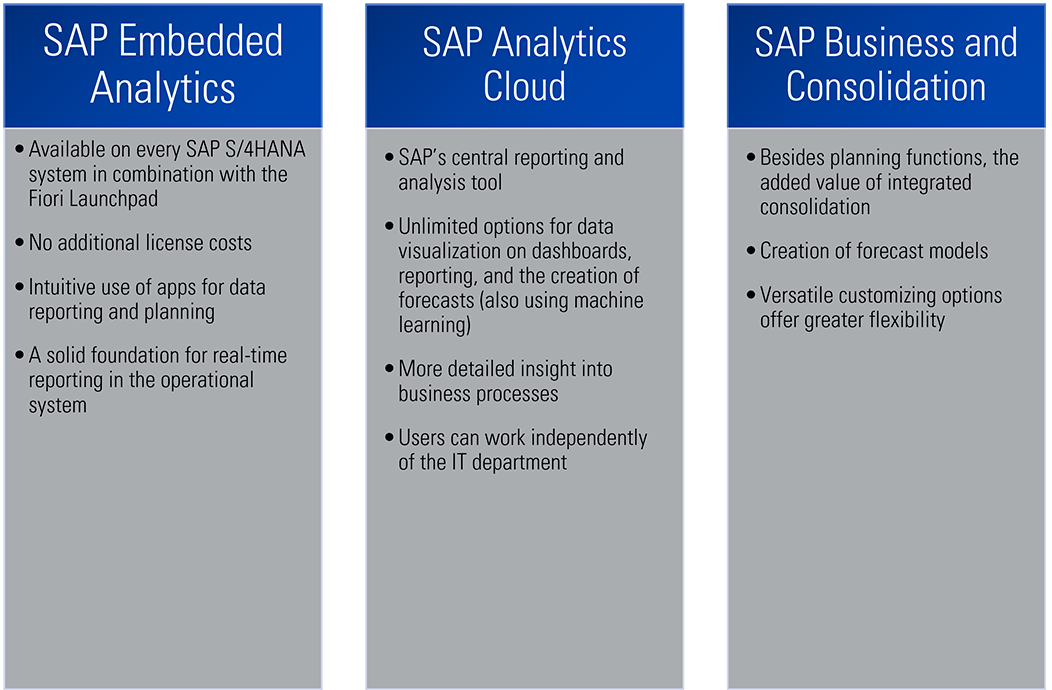SAP S/4HANA Migration:
New SAP Tools for Financial Planning
SAP offers a number of new financial planning tools to accompany the migration to SAP S/4HANA: SAP Embedded Analytics, SAP Analytics Cloud (SAC), or SAP Business Planning and Consolidation (BPC). A target/actual analysis can identify which solution is best for your company. XEPTUM will help you determine your individual planning requirements.
To map financial planning in SAP, many companies today are still using the SAP Report Painter, non-SAP tools, or even Excel spreadsheets. This all has to stop when implementing SAP S/4HANA, however, as the Report Painter is no longer available with S/4HANA. Decision-makers now have to rethink their SAP financial planning strategy and adopt new SAP solutions. This also gives them the opportunity to optimize and digitalize planning processes, particularly through the use of the latest machine learning (ML) technologies.
Which SAP Tools Support Financial Planning in S/4HANA?
SAP Embedded Analytics in SAP S/4HANA is a new, directly integrated tool for operational reporting. In addition to standard analytical apps, which are accessed via the SAP Fiori Launchpad, it also offers CDS views and BEx Queries with new capabilities for real-time reporting based on the innovative in-memory technology. Embedded Analytics gives companies the flexibility to adapt their financial planning to changing market requirements.
The reports and KPIs are based on standard SAP processes, enabling direct analysis in the operational system as well as a seamless transition between transactional and analytical apps in the Fiori Launchpad with real-time reporting.
SAP Analytics Cloud (SAC) is a cloud-based, Software-as-a-Service (SaaS) product from SAP. Once activated, SAC is available directly in the browser and provides a wide range of analytics capabilities. The tool not only combines business planning with business intelligence, but also leverages machine learning (ML) to expand the analysis options with wide-ranging predictive analytics models.
With SAC, reporting is not limited to SAP data or standard SAP processes. It is also possible to map complex scenarios and link planning and actual data from SAP and non-SAP systems. SAC offers dashboards for data visualization and tools for planning and forecasting. Users have the option of creating and managing their own reports and plans. The tool is designed to support flexible planning while leveraging new technologies such as ML.
SAP Business Planning and Consolidation (BPC) offers comprehensive planning functions as well as integrated consolidation capabilities. The extensive customizing settings allow companies to map both centralized and decentralized planning processes. SAP BPC is installed on premises on the basis of an SAP Business Warehouse (BW) system, but can also be embedded within SAP S/4HANA. It is extremely flexible, supporting the creation of planning scenarios for a wide range of organizational units. Users can also implement and manage their own plans with BPC.
What are the Advantages and Disadvantages of the SAP Financial Planning Solutions in SAP S/4HANA?
Embedded Analytics is available on every SAP S/4HANA system in combination with the Fiori Launchpad. This has the advantage that no further license fees are incurred. The use of apps for data reporting and planning is also very intuitive. Embedded analytics offers a solid foundation for real-time reports in the operational system. The closer the relevant business processes and KPIs are to the SAP standard, the more reporting capabilities can be used.
More extensive reports require IT development support. SAP Embedded Analytics is aimed at users and business analysts, but does not offer a high level of flexibility for customizing reports or analyses.
SAP Analytics Cloud (SAC) is SAP’s central reporting and planning tool and offers countless options for data visualization on dashboards, customized reporting, and the creation of forecasts, also using ML. SAC is therefore suitable not only for users, but also for C-level reporting thanks to its comprehensive display capabilities. Stakeholders from all areas receive detailed insights into the business processes.
With SAC, users can work largely independently of IT as the tool can be set up and used with user resources. It is less suitable for central planning applications, however, and is mostly recommended for area-specific planning functions. License costs must always be included in a cost-benefit analysis.
SAP Business Planning and Consolidation (BPC) offers, in addition to planning functions, the added value of integrated consolidation. BPC can also be used to create forecast models, although these functions are increasingly being transferred to the cloud-based SAC solution and further developed by SAP. BPC’s many customizing options offer a high degree of flexibility. However, many developments have to be implemented by IT as users are unable to complete all the required customizing activities in the system themselves.
License costs must also be taken into account with BPC, or even a standalone system if the customer does not want to use the embedded version of BPC.

